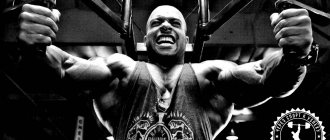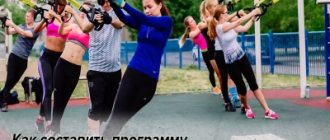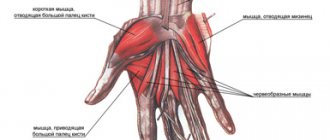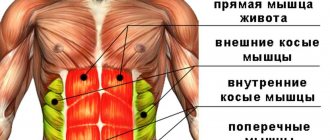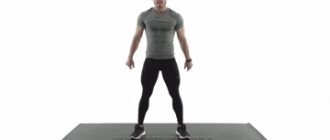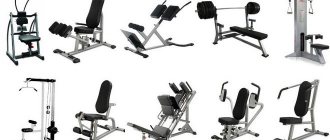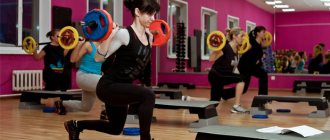We continue to post exercises from the complex for beginners, which includes 6 diverse workouts. They are designed for those who want to lose weight and improve their body quality. You can follow the program if you are just starting to exercise or if you are returning to fitness after a long break.
Below are the exercises for the fourth day of classes - upper body training (arms, shoulders, stomach, back, chest).
Workouts for beginners: description
1. We offer you 6 ready-made sets of exercises:
- Mon: Lower body workout (hips and buttocks)
- VT: Interval training for weight loss and body tone
- CP: Low-impact cardio without jumping
- CT: Upper Body Workout – Below
- PT: Circuit training for problem areas
- SB: Full body stretching
Repeat the program for 6-8 weeks, during which time you will be able to reduce volume, get rid of excess fat, develop endurance, tighten your arms, chest, stomach, thighs, buttocks. This affordable exercise routine will help you ease into your fitness regime.
2. Duration of training is 30 minutes, including warm-up for 5 minutes and stretching for 5 minutes. That is, the duration of the main lesson without warm-up and stretching is 20 minutes. This is an ideal time for beginners to work on target muscles without overdoing it.
3. The training is designed for beginners and beginners-intermediate levels of physical fitness. Some exercises are challenging enough that you can progress from week to week. The description also suggests a simplified version of the exercise, but gradually you should strive to complete the original version of the exercise without modification. You can always make a workout harder or easier by changing the number of reps or timing of the exercises.
See our selection of exercises:
- Top 60 Best Cardio Exercises
- Top 50 best leg exercises
- Top 50 best exercises for buttocks
- Top 50 Best Abdominal Exercises
- Top 30 best arm exercises
4. For training, you will need a mat and some free space in the room. No other additional equipment is needed. We recommend training in sneakers and comfortable sportswear made from natural materials.
5. All workouts are low-impact, performed without jumping. The program is suitable for those who want to lose weight, burn fat and tighten their body.
6. The upper body workout suggested below consists of the following segments:
- Warm-up warm-up (5 minutes)
- First round: 7 exercises repeated in two rounds (~10 minutes)
- Second round: 7 exercises repeated in two rounds (~10 minutes)
- Muscle stretching (5 minutes)
7. An upper body workout includes functional exercises that will allow you to work several muscle groups at once. The emphasis in this program is on the upper body (arms, shoulders, chest, back, stomach), but the lower body is also included in the work, albeit to a lesser extent. There is no cardio exercise per se, but by quickly changing exercises, your heart rate will be high throughout the session, which will help you burn more calories.
8. This program can be performed for a time or number of repetitions of your choice. If you want to do this interval training for weight loss on a count, then the exact number of repetitions is indicated below in the description for each exercise. Please note that if you perform counting exercises without a timer, the total time of the program may differ from the stated one, since the pace of the workout will be individual. Do not take much rest between exercises if you are training on the count, this will reduce the effectiveness of the exercise.
9. If you want to train according to time, then the exercises in both rounds are performed according to the scheme 30 seconds work / 10 seconds rest. Those. You perform a given exercise for 30 seconds, then rest for 10 seconds and prepare for the next exercise, then perform the next exercise for 30 seconds, etc. You can take a longer break between laps, for example, 30 seconds - be guided by your capabilities. To perform using a timer, download a mobile phone application (for example, Tabata Timer) or turn on a ready-made video with a timer.
10. Gradually the body gets used to the load, so in the future it is necessary to move on to more complex and intense programs.
- Mon: Intense workout for legs and buttocks
- VT: Advanced Upper Body Workout
- CP: Intense cardio workout at 500 kcal
- CT: Low impact floor workout for problem areas
- PT: Interval training for weight loss and body tone
Exercises for COVID-19 survivors
- Help from professional rehabilitation specialists;
- Individual recovery program;
- Modern techniques and equipment.
The main problem for most people who have recovered from coronavirus is a long recovery. Weakness throughout the body due to prolonged lack of physical activity interferes with leading a normal lifestyle and prevents you from doing your favorite activities and work.
The best solution in this situation is to contact specialists to draw up an individual rehabilitation program after COVID-19 . Our doctors already have experience working with patients who have recovered from Covid. Contact KIT and we will create a personal recovery program that suits you! Also, do not forget about a set of physical exercises that will help you tone up and will be an excellent addition to your rehabilitation program.
The appointment is conducted by doctors
Khomudyarova Alena Nikolaevna
— neurologist, hirudotherapist, reflexologist, work experience of more than 10 years.
Ask a question More details...
Shalaev Sergey Alekseevich - doctor of medical and physical rehabilitation, traumatologist-orthopedist, chiropractor. Has extensive experience working with children. Work experience 15 years.
Ask a question Read more...
Warm-up
Warm-up is a mandatory part of the workout, do not skip it under any circumstances. Warming up will prepare your muscles and heart for the load, increase blood circulation, and warm up your body, which will help you perform your workout as efficiently as possible.
Warm-up should take place at a dynamic pace; your task is to warm up the body. Warm-up exercises are performed for 30 seconds without rest between exercises.
The warm-up includes the following exercises:
- Shoulder rotation: 15 rotations in each direction (30 seconds)
- Arm rotation: 15 rotations in each direction (30 seconds)
- Elbow rotation: 15 rotations in each direction (30 seconds)
- Body turns: 10 turns in each direction (30 seconds)
- Leg bends: 8 bends in each direction (30 seconds)
- Side bends: 15 bends in each direction (30 seconds)
- Side abduction: 15 reps each side (30 seconds)
- Side step with bent arms: 15 reps on each leg (30 seconds)
- Side step with arm extension: 15 repetitions on each leg (30 seconds)
- Walking with crossed arms: 15 repetitions on each leg (30 seconds)
1. Shoulder rotation
We start the workout by warming up the shoulders. Stand straight with your feet shoulder-width apart. Start rotating your shoulders: forward, up, back, down. Perform the exercise with amplitude, bringing your shoulder blades together as you move your shoulders back. Don't forget to rotate in the opposite direction as well.
How much: 15 rotations in each direction (30 rotations in total) or 30 seconds.
2. Arm Rotation
Stay upright. Stretch your arms up and begin to rotate them in a circle. Feel your body begin to warm up. First rotate your arms forward, then backward.
How much: 15 rotations in each direction (30 rotations in total) or 30 seconds.
3. Elbow rotation
Bend your elbows so that your shoulders (the part of your arm above the elbow) are parallel to the floor. Start rotating your elbows in a circle, stretching your elbow joints and forearms. Rotate forward first, then backward.
How much: 15 rotations in each direction (30 rotations in total) or 30 seconds.
4. Body turns
Spread your arms to the sides, they should be parallel to the floor. Start turning your body to the sides, stretching your abdominal and back muscles. Your core will be working hard during this workout, so it's important to stretch your muscles well before starting.
How much: 10 turns in each direction (30 turns in total) or 30 seconds.
5. Tilts towards the feet
Leave your arms out to the side. Start bending over, trying to touch your hands to the floor. Do not round your back, bring your shoulder blades together, stretch the muscles of the back of your thigh, back, shoulders, and arms.
How much: 8 bends in each direction (16 bends in total) or 30 seconds.
6. Tilts to the side
Place your hands on your belt. Start doing alternating side bends with your arm raised. Stretch to the side not with your neck, but with your entire body. The pelvis remains stable.
How much: 15 bends in each direction (30 bends in total) or 30 seconds.
7. Abduction of arms to the sides
Leave your hands on your belt. Spread your legs wide and begin to move your arms out to the sides at chest level. Rotate your body by twisting at the waist.
How much: 15 repetitions in each direction (30 repetitions total) or 30 seconds.
8. Steps to the side with arms bent at the elbows
Better yet, warm up your body by doing a few exercises that involve your upper and lower body. Bend your elbows and lift them so that your arms are parallel to the floor. Step sideways at a dynamic pace, simultaneously spreading your arms wide to the sides and bringing them together. This is an excellent exercise for warming up the pectoral and shoulder muscles.
How much: 15 steps in each direction (30 steps in total) or 30 seconds.
9. Side step with arm extension
We continue with the side steps, but we change the upper body movement to warm up the biceps and triceps. Walk in place, simultaneously bending and straightening your arms. When extending your arms, move them back behind your back. The arm muscles will be involved in most exercises, so it is very important to stretch them well before exercising.
How much: 15 steps in each direction (30 steps in total) or 30 seconds.
10. Knee raises with crossed arms
Start walking in place, raising your knees high until your thighs are parallel to the floor. At the same time as you walk, spread your arms wide to the sides (bring your shoulder blades together) and cross them together at chest level (as if you were trying to hug yourself).
How much: 15 steps in each direction (30 steps in total) or 30 seconds.
Upper Body Workout: Round 1
The first round of the upper body workout lasts ~10 minutes. This round includes 7 diverse exercises that are repeated in two circles. Each lap lasts ~5 minutes.
Exercises are performed according to the scheme 30 seconds work / 10 seconds rest. Can be performed without a timer, counting the number of repetitions.
The first round includes the following exercises:
- Bends to the side: knee-elbow: 13 repetitions on each side (30 seconds)
- Toe touch plank: 10 reps on each side (30 seconds)
- Crunch with legs up: 20 reps (30 seconds)
- Hunting Dog: 18 reps (30 seconds)
- Kneeling side plank: 18 reps (30 seconds)
- Half-sitting thigh-to-abdominal pull-up: 15 reps on each side (30 seconds)
- Swimmer: 10 reps on each side (30 seconds)
We repeat the exercises in two circles. Rest 30-60 seconds between circuits. Exercises No. 4 and No. 5 in the first circle are performed on the right side, in the second circle on the left side.
1. Bends to the knee-elbow side
Why: This exercise is aimed at working the oblique muscles of the abdomen and waist area. Additionally, you will include your legs in the work, especially the riding breeches area.
How to do it: Stand straight, legs slightly apart, bend your elbows and cross your arms behind your head. Take your right leg bent at the knee to the right and lift it up. At the same time, tilt your body to the right, trying to reach the knee of the raised leg with your elbow. Perform alternately on both sides.
Lightweight version: You can bend to the side without lifting your legs.
How long to do: 13 reps on each side (26 reps total) or 30 seconds.
2. Plank with feet touching
Why: This is a great functional exercise for the entire body, focusing on the stomach, back and arms. This exercise is also useful for stretching the spine and improving posture.
How to do it: Get into a hand plank position. Tighten your stomach, straighten your back, do not bend or arch your lower back. As you exhale, lift your pelvis up, twist your body and pull your hand towards the foot of the opposite leg. In the extreme position, you will actually be standing in a downward-facing dog pose. In this exercise, it is important not to round your back, try to stretch your spine. Also, do not bend your knees, increasing the load on the hamstrings. Perform the exercise alternately on both sides.
Easy version: To make this upper body exercise easier, reach with your hand not toward your foot, but toward the thigh of the opposite leg.
How long to do: 10 reps on each side (20 reps total) or 30 seconds.
3. Leg Elevated Crunch
Why: Crunches are a classic abdominal exercise, so it would be criminal not to include them in your upper body routine. Let's complicate this exercise a little by raising the legs.
How to do it: Lie on your back, arms spread behind your head, stomach tense, lower back pressed firmly to the floor. As you exhale, lift your upper back off the floor, leaving your lower back on the floor. Elbows continue to point in opposite directions, do not pull them towards your feet. In this exercise, it is very important to press your lower back to the floor during all phases of the exercise. If you have a gap between your back and the floor, then the entire load falls on your lower back. And this, firstly, is not useful, and secondly, the exercise ceases to be effective.
Easier Version: For an easier version of this ab exercise, lower your feet to the floor.
How long to do: 20 repetitions or 30 seconds.
4. "Hunting Dog"
Why: This is a simple and very effective exercise for the abdomen, back and posture, as well as for developing balance and stabilizing muscles.
How to do it: Get on all fours with support on your palms and knees. Raise your right arm and left leg as high as possible. This is the starting position. As you exhale, twist your back and bend your arm and leg so that your elbow touches your knee. Return to the starting position. Continue doing this exercise on one side, then perform the second round on the other side.
Lighter version: Perform this exercise in a static version, maintaining a balance position with your arms and legs raised up.
How long to do: 18 repetitions or 30 seconds. For the second round, perform this exercise on the other side.
5. Side plank on knees
Why: The side plank is one of the most effective exercises for the oblique muscles of the abdomen and shoulder girdle. But at the same time one of the most difficult for beginners. If your core muscles are weak enough, you will have a very difficult time maintaining balance in a side plank. That's why we offer you a version of the side plank on the knees, which is no less effective for developing the upper body.
How to do it: Lie on your side with support on your right forearm, your left hand on your waist. The right leg is bent at the knees, the thigh lies on the floor, the lower leg is laid back. The left upper leg is fully straightened and rests on the foot. As you exhale, lift your pelvis as high as possible, tensing your abdominal muscles. Do not lean your body back and forth; your body maintains a straight line. Pause for a second in the upper position and lower back to the floor.
Easier Version: For an easier version of this upper body exercise, remain in a static side plank position with your torso lifted and your pelvis pulled upward.
How long to do: 18 repetitions or 30 seconds. For the second round, perform this exercise on the other side.
6. Pulling the thighs to the stomach while half-sitting
Why: This is an excellent exercise for the upper and lower abs, which puts minimal stress on the spinal region. If you feel pain in the lower back, neck or back after abdominal workouts, then these exercises will be a good alternative for pumping up your abdominal muscles.
How to do it: Sit on the floor, bend your knees, raise your arms above your head. Bend your straight back slightly back. This is the starting position. Pull your hips towards your stomach while lowering your hands towards your knees. Feel how your core muscles work. Perform the exercise alternately on both sides. Work dynamically.
Easier Option: For an easier version of this ab exercise, grab your leg as you pull your thigh toward your stomach and don't raise your arms too high.
How long to do: 15 reps on each side (30 reps total) or 30 seconds.
7. Swimmer
Why: Swimming is one of the most useful and effective fitness exercises that develops the muscles of the whole body, but especially the muscles of the back, arms, lower back, shoulders, buttocks and abdomen. This is also a great exercise for improving your posture.
How to do it: Lie on your stomach, legs together, arms extended in front of you, head raised above the floor. Inhale and as you exhale, lift your right arm and left leg as high as possible, trying to lift your chest and thigh off the floor. Hold for a second and return to the starting position. Perform the exercise alternately on both sides.
Easier Version: For an easier version of this upper body exercise, lift only your arms up while keeping your feet flat on the floor.
How long to do: 10 reps on each side (20 reps total) or 30 seconds.
After finishing the first round, rest for 30-60 seconds, after finishing the round, rest for 60 seconds. It is better not to lie on the floor, but to walk in place.
Training program to lighten the T-type “top”
- Dumbbell press, dumbbell flyes (on an incline bench).
- Lifting dumbbells through the sides, bent over raises.
- Dumbbell row with one hand, row on the upper block to the chest.
- Curling your arms on a block, lifting dumbbells for your biceps with a twist of your wrist.
- Bench push-ups, overhead extensions.
Monday Thursday
Before starting the training, you should definitely warm up. As an example - 5-10 minutes of leisurely walking.
The exercises should be performed in the form of supersets with moderate weight and a high (12–15) number of repetitions.
Training program
| Exercises | Sets | Repetitions |
| Superset: dumbbell press plus incline flyes | Two supersets with a break of 30–45 seconds* | 12–15 for each exercise |
| Superset: dumbbell lateral raises plus bent over flyes | Two supersets with a break of 30–45 seconds* | 12–15 for each exercise |
| Superset: one-arm row plus lat pull-down | Two supersets with a break of 30–45 seconds* | 12–15 for each exercise |
| Superset: cable curls plus dumbbell curls with wrist twist | Two supersets with a break of 30–45 seconds* | 12–15 for each exercise |
| Superset: push-ups plus overhead extensions | Two supersets with a break of 30–45 seconds* | 12–15 for each exercise |
*Increase the weight for each subsequent set.
Aerobics
If you are not afraid of losing some muscle mass: after an athletic workout, do aerobics for 20-30 minutes, for example, on a rowing machine, stair machine, ski machine, exercise bike, or just walk with weights.
Upper Body Workout: Round 2
The second round of the upper body workout lasts ~10 minutes. This round also includes 7 exercises that are repeated in two circles. Each lap lasts ~5 minutes. Exercises are performed according to the scheme 30 seconds work / 10 seconds rest. Can be performed without a timer, counting the number of repetitions.
The second round includes the following exercises:
- Standing knee-elbow crunch: 15 reps on each side (30 seconds)
- Spider Plank: 12 reps each side (30 seconds)
- Pulling straight legs to the stomach: 15 repetitions (30 seconds)
- Reverse push-ups + leg raises: 9 reps (30 seconds)
- Kickback while lying on your stomach: 10 reps on each side (30 seconds)
- Plank Raises: 10 reps on each side (30 seconds)
- Oblique crunch: 18 reps (30 seconds)
We repeat the exercises in two circles. Rest 30-60 seconds between circles. Exercises No. 7 in the first circle are performed on the right side, in the second circle on the left side.
1. Standing knee-elbow crunch
Why: This simple exercise will help you strengthen your rectus abdominis and oblique abdominal muscles. In addition, the exercise engages the muscles of the lower body, which will provide additional calorie burning.
How to do it: Stand straight, feet shoulder-width apart, stomach tense. The arms are slightly bent at the elbows and raised above the head, palm resting on palm. As you exhale, lower your arms and lift your right knee up so that the elbow of your left hand touches your right thigh. Twist your body, tighten your abdominal muscles. Perform the exercise alternately on both sides.
Lighter version: In a simplified version, keep your hands motionless along your chest, without raising them up.
How long to do: 15 reps on each side (30 reps total) or 30 seconds.
2. Spider plank
Why: This is an excellent exercise for the oblique muscles of the abdomen and waist area. Like any other modification of the plank, this exercise develops absolutely all the muscles of your body, but especially the shoulders, buttocks, hips, and core.
How to do it: Get into a hand plank position. Tighten your stomach, straighten your back, do not bend or arch your lower back. Inhale and as you exhale, bring your right knee toward your right elbow. As you inhale, return to the starting position and repeat on the other side.
Lighter version: In the simplified version, do 4-6 repetitions, lower yourself into the plank on your knees for 5 seconds and return to the execution. Gradually try to minimize rest.
How long to do: 12 reps on each side (24 reps total) or 30 seconds.
3. Pulling straight legs to the stomach
Why: This Pilates exercise will help you strengthen your abdominal muscles, and the emphasis in this exercise is on the lower abdomen. Additionally, Pilates is an ideal technique for strengthening your core and improving your posture.
How to do it: Lie on your back with your upper back raised off the floor. Stretch your legs and lift them up, and also lift your arms up above your head. Tighten your stomach, keeping your lower back firmly pressed to the floor. As you exhale, pull your knees toward your stomach, lightly clasping your shins with your hands. Hold for a split second and return to the starting position. In this exercise, it is important to understand that the lower your legs are to the floor, the more difficult it is to perform the exercise. When performing this exercise, tense your stomach so as not to put stress on your lower back.
Easier Version: For an easier version of this ab exercise, lift your legs higher and keep your arms down.
How long to do: 15 repetitions or 30 seconds.
4. Reverse push-ups + leg raises
Why: Reverse push-ups are an excellent isolation exercise for the triceps of the arms. It is the triceps area in girls that most often becomes flabby and unattractive (the back of the arms), so exercises for this area are simply necessary. Let's complicate the reverse push-ups by lifting the legs, thereby additionally engaging the abdominal muscles in the work. Also in this functional exercise you use the muscles of the thighs and buttocks.
How to do it: Stand in table pose, legs bent at the knees, arms along the body slightly behind, palms and feet resting on the floor, palms facing forward, pelvis slightly lowered, stomach tense. As you exhale, slowly bend your elbows and lower your buttocks close to the floor. Return to the starting position and, without pausing for more than a split second, alternately lift one and the other leg up perpendicular to the floor. Then return to the starting position and start the exercise over again.
Light version: In the light version you can reduce the number of push-ups. Those. Perform one reverse push-up for every 4 leg raises. You can lift up not your straight leg, but your knee.
How long to perform: 9 repetitions or 30 seconds. One repetition is a push-up + lifting the right and left legs.
5. Pulling your arms back while lying on your stomach
Why: This simple exercise will help you strengthen your back muscles, lumbar muscles, shoulder muscles and arms. This exercise will also be useful for straightening the spine and improving posture.
How to do it: Lie on your stomach with your arms extended in front of you and parallel to each other. As you exhale, lift your chest up, move your arm back to your back and twist your body so that your fingers touch your thigh. Don't strain your neck, move your shoulders away from your ears. Feel the pleasant tension in your lower back and back, as well as the stretching of your spine. Perform the exercise alternately on both sides.
Easier Version: For an easier version of this upper body exercise, don't move your arm too far back, but stay in a comfortable position.
How long to do: 10 reps on each side (20 reps total) or 30 seconds.
6. Forearm plank raises
Why: This exercise works all the muscles of the body due to the complex position of the plank on the forearms, but especially the muscles of the shoulders and triceps, as well as the pectoral muscles and back muscles. This is a rather difficult exercise, so at first perform it on your knees, gradually trying to do it in a plank on your feet.
How to do it: Take a plank position on your forearms: the body forms a straight line, the lower back does not bend or arch, the stomach and buttocks are tense, the neck is free, the gaze is directed forward. Maintaining the correct body position, extend your arm forward as if trying to reach the wall in front. Perform alternately on both sides, do not strain your neck while performing.
Easier Version: For an easier version of this upper body exercise, drop to your knees. You can do it for 15 seconds on your feet, 15 seconds on your knees, for example.
How long to do: 10 reps on each side (20 reps total) or 30 seconds.
7. Twisting at an angle
Why: This exercise works well on the oblique abdominal muscles, as well as the upper and lower abs. It is quite simple both from a technical point of view and from a performance point of view.
How to do it: Lie on the floor, legs slightly apart, abdominal muscles tense, back pressed to the floor. The left arm is straightened and moved to the side, the right arm is raised diagonally upward. As you exhale deeply, lift your left leg up so that it is perpendicular to the floor. At the same time, lift your upper back, extending your arm until it touches your shin. Perform the exercise on one side in the first circle and on the other side in the second circle.
Lighter version: For a lighter version of this abdominal exercise, lift your leg up with your knee bent.
How long to do: 18 repetitions or 30 seconds. For the second round, repeat this exercise on the other side.
After finishing the first circle and round, rest for 30-60 seconds.
Training schemes
Circuit training.
For the development of core body muscles, circuit training is well suited because you get the necessary load on both the muscles and the cardiovascular system due to the intensity of the training, which in turn does not require additional cardio training.
To create a training plan, choose about five exercises (1-2 from each list above) and perform them one after another, without rest. Work in the range of 8-12 reps per exercise for 2-4 full circles, depending on your starting level of training.
Since you'll be performing five exercises in a row, you may need to use lighter weights than usual.
Remember that you do not rest between exercises, but only between circles for 2-3 minutes. If you're creating multiple circuits, make sure you're training your body evenly and choosing exercises for each major muscle group.
Training scheme (circular principle)
2 - 4 laps:
1. Incline dumbbell press, 8 to 12 reps.
2. Bent-over dumbbell rows, 8 to 12 reps.
3. Lifting dumbbells in front of you for 8 – 12 repetitions.
4. Standing dumbbell curls for biceps, 8 to 12 reps.
5. French dumbbell press while seated, 8 to 12 reps
Rest 2-3 minutes between circles.
Normal execution.
There's nothing fancy about this training scheme, you do all the sets and reps of an exercise and then move on to the next one and so on.
Some upper body workouts are structured to prioritize the lagging mice and work them early in the routine.
So, if your shoulders are a weak link, start with a heavier exercise before moving on to lighter isolation movements.
To maximize muscle growth, do 3-4 sets of 8-12 reps of each exercise, resting 1-2 minutes between sets.
Read also: 2 butt workouts for women: maximum volume.
This rest time will allow you to lift heavier weights, which will increase your strength. If you want to increase your heart rate, rest 30-60 seconds between sets, thereby increasing the intensity of your workout.
If you want to focus on strength work, choose a compound exercise such as the bench press. Do fewer reps and focus on training with heavier weights.
Workout scheme (regular execution)
1. Standing barbell press (military press) – 3, 4 sets of 5 – 8 repetitions.
2. Raises of arms with dumbbells lying on an inclined bench face down - 3, 4 sets of 8 - 12 repetitions.
3. Raising dumbbells in front of you while standing – 3, 4 sets of 8 – 12 repetitions.
4. Reduction of arms in a crossover lying on a horizontal bench - 3, 4 sets of 8 - 12 repetitions.
5. Wide grip lat pull-down – 3, 4 sets of 8 – 12 reps.
6. Concentrated biceps curl – 3, 4 sets of 8 – 12 repetitions.
7. Extension of arms from the upper block – 3, 4 sets of 8 – 12 repetitions.
Rest 1-2 minutes.
Supersets.
I think everyone is familiar with the superset training technique. To implement it, perform two exercises one after the other, without rest. The essence of the superset is to work the antagonist muscles, which perform opposite functions (pulls/presses)
For example, you can combine chest and back exercises or biceps and triceps exercises to get the most out of this technique.
The great thing about supersets is that they add intensity to your workouts and allow you to train two body parts at the same time.
Train in the 8-12 rep range with 1-2 minutes rest between supersets. Complete all sets for one superset before moving on to the next pair of exercises.
If you want to add some strength work to this type of workout, choose one compound exercise, such as the bench press or press press, and do a few heavy sets of the individual exercise before you start working on supersets.
Training scheme (supersets)
Superset:
1A. Push-ups – 2, 3 sets of 8 – 12 repetitions.
1B. Pull-ups – 2, 3 sets of 8 – 12 reps.
Superset:
2A. Dumbbell curls on a horizontal bench – 2, 3 sets of 8 – 12 repetitions.
2B. Wide grip lat pull-down – 2, 3 sets of 8 – 12 reps.
Superset:
3A. Seated dumbbell press – 2, 3 sets of 8 – 12 reps.
3B. Bent-over dumbbell rows – 2, 3 sets of 8 – 12 reps.
Superset:
4A. Raising the barbell for biceps – 2, 3 sets of 8 – 12 repetitions.
4B. Dips (emphasis on triceps) – 2, 3 sets of 8 – 12 repetitions.
Rest 1-2 minutes between supersets.
Complex sets.
Complex sets are similar to supesets, but instead of training opposite muscle groups (antagonists), you will combine exercises that work the same muscle group.
Read also: Strength training in the style of the Tabata protocol.
Doing two exercises per muscle group is a great way to add intensity to your workouts. Not only will your muscles be completely exhausted after a few sets, but the cardio load from such training will help you burn even more calories.
As in the previous workout, use 2-3 sets of 8-12 repetitions. Because these sets are quite intense, you may need to tone down the load a little to make it through the workout, especially on later sets. Rest 2-3 minutes between complex sets.
In this case, you can combine multi-joint exercises with isolation exercises. Or heavy exercises with weights and exercise by hanging your own body.
Many people like to start with a heavy exercise and then hit the same muscle group with a lighter movement. This choice can be endless and will depend on your goals.
Training scheme (complex sets)
Complex set:
1A. Pull-ups – 2, 3 sets of 8 – 12 reps.
1B. Wide grip lat pull-down – 2, 3 sets of 8 – 12 reps.
Complex set:
2A. Bent-over dumbbell raises – 2, 3 sets of 8 – 12 repetitions.
2B. Standing barbell press – 2, 3 sets of 8 – 12 sets.
Complex set:
3A. Arnold press - 2, 3 sets of 8 - 12 reps.
3B. Dumbbell curls lying on a horizontal bench – 2, 3 sets of 8 – 12 repetitions.
Complex set:
4A. Raising biceps from the lower block - 2, 3 sets of 8 - 12 repetitions.
4B. Lifting dumbbells for biceps while lying on an inclined bench – 2, 3 sets of 8 – 12 repetitions.
Complex set:
5A. French bench press – 2, 3 sets of 8 – 12 reps.
5 B. Extension of arms from the upper block – 2, 3 sets of 8 – 12 repetitions.
Rest between complex sets, 2-3 minutes.

